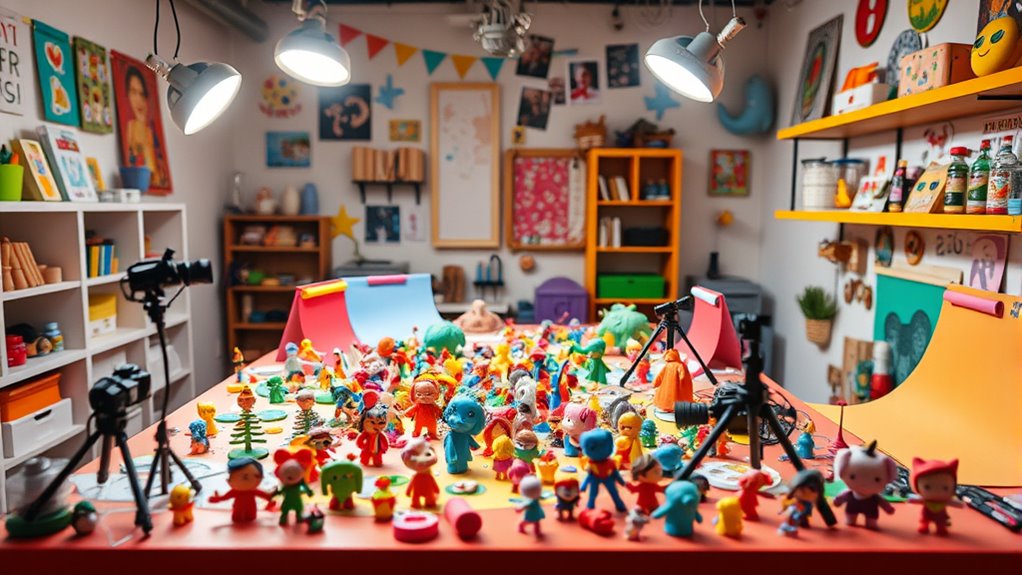Setting up a stop-motion studio for kids is simple and budget-friendly. Use a smartphone or tablet on a stable surface to film, and create a dedicated space to stay organized. Encourage kids to experiment with different materials like clay, paper, or toys, and guide them to move objects frame by frame. Planning scenes with storyboards and troubleshooting lighting or camera angles helps improve projects. Keep exploring to discover even more tips and ideas to boost your child’s creativity.
Key Takeaways
- Use a smartphone or tablet on a stable surface to set up a dedicated filming space.
- Gather simple materials like clay, paper, or toys to create animated scenes.
- Plan your story with storyboards and set up scenes before filming.
- Capture images frame-by-frame, moving objects slightly between shots for smooth animation.
- Edit the sequence to improve storytelling, timing, and visual quality, celebrating finished projects.

If your kids love storytelling and creativity, a stop-motion studio can be a fantastic way to bring their ideas to life. Setting up a simple studio at home empowers them to explore animation techniques and storytelling methods firsthand. By doing so, you give your children the tools to craft their own animated stories, fostering both their imagination and technical skills. Creating a stop-motion studio is easier than you might think, and it can be tailored to fit your space and budget. All you need is a camera—most smartphones or tablets work perfectly—and a stable surface to serve as your set.
Once you have your equipment, the key is to teach your kids basic animation techniques. They learn how to carefully move objects or characters slightly between shots, then compile these images into a seamless sequence. This process introduces them to fundamental animation principles like frame-by-frame movement, timing, and pacing. As they experiment with different objects—clay figures, paper cutouts, or toys—they also discover how different materials can influence the look and feel of their stories. This hands-on approach makes the learning process engaging and directly connected to their creative ideas.
Teaching kids to move objects frame-by-frame builds their understanding of animation fundamentals.
Storytelling methods are central to making compelling stop-motion films. Encourage your kids to develop a simple plot or concept before starting filming. They can sketch storyboards to visualize scenes and plan their shots. This helps them understand narrative structure, character development, and pacing. As they set up scenes and capture frames, they learn to think critically about how each shot contributes to the overall story. The process of editing their clips into a final video enhances their understanding of storytelling flow, timing, and emotional impact. It’s a wonderful way to combine creative writing with visual storytelling techniques.
Throughout this process, your kids will gain confidence in both their technical abilities and their narrative skills. As they troubleshoot issues like lighting, camera angles, and movement, they develop problem-solving skills. They also learn patience and persistence, especially when a scene doesn’t turn out as planned. Watching their ideas come alive frame by frame provides a sense of accomplishment and inspires continued creativity. Plus, sharing their finished projects with family or friends offers a rewarding opportunity to celebrate their work and boost their confidence.
Building a stop-motion studio at home isn’t just about making movies; it’s about nurturing a love for storytelling, art, and technology. It’s a fun, educational activity that sparks imagination and encourages your kids to think outside the box. With a little guidance and encouragement, they’ll develop valuable skills that extend beyond animation, all while having a great time turning their ideas into animated adventures. Additionally, understanding the importance of color accuracy and proper lighting can help improve the visual quality of their films, making their stories even more captivating.
Frequently Asked Questions
What Is the Ideal Age Range for Kids to Start Stop-Motion Filmmaking?
You can start introducing kids to stop-motion filmmaking around age 8, as they begin developing the necessary technical skills and creative storytelling abilities. At this age, children can handle simple equipment and understand basic concepts, making it a perfect time to foster their creativity. As they grow older, they’ll refine their skills and create more complex stories, boosting their confidence and artistic expression through engaging stop-motion projects.
How Much Space Is Needed to Set up a Kid-Friendly Stop-Motion Studio?
You’ll need a dedicated space around 4×6 feet for a kid-friendly stop-motion studio. Design a simple studio layout with a sturdy table for filming, adjustable lighting, and a backdrop area. Incorporate storage solutions like shelves or bins to keep materials organized and accessible. confirm there’s enough room for kids to move comfortably, and keep everything within reach to make the filmmaking process fun and manageable.
Are There Any Safety Concerns With Using Specific Materials or Tools?
Did you know that over 60% of parents prioritize safety when kids use art supplies? You should always guarantee you use non-toxic materials and age-appropriate tools in your stop-motion studio. This minimizes risks like choking or skin irritation. Always supervise children closely, especially when handling small items or sharp tools. Choosing safe, child-friendly equipment helps foster creativity without compromising safety.
Can Children Create Stop-Motion Videos Without Prior Experience?
Absolutely, children can create stop-motion videos without prior experience. Digital animation tools designed for kids simplify the process, making it easy and fun to learn. They can focus on creative storytelling, bringing their ideas to life with minimal guidance. With patience and practice, young creators develop skills in animation, storytelling, and technology, gaining confidence in their abilities while exploring their imagination through engaging, hands-on projects.
How Long Does It Typically Take to Produce a Short Stop-Motion Film?
You can usually complete a short stop-motion film in a few hours to a few days, depending on your animation techniques and story complexity. While it might seem time-consuming, breaking the process into manageable steps makes it fun and achievable. Use storytelling tips to keep your narrative engaging, and remember, patience and creativity are key. With practice, you’ll improve your efficiency and create fantastic animated stories faster.
Conclusion
Now that you’ve built your stop-motion studio, you’ve opened the door to endless creative adventures. Think of your studio as a magic garden, where each scene you create is a new flower blooming with imagination. With a little practice, you’ll become a master gardener of stories, nurturing your ideas into vibrant, moving masterpieces. So, keep experimenting, have fun, and watch your tiny worlds grow into incredible worlds of your own making.










